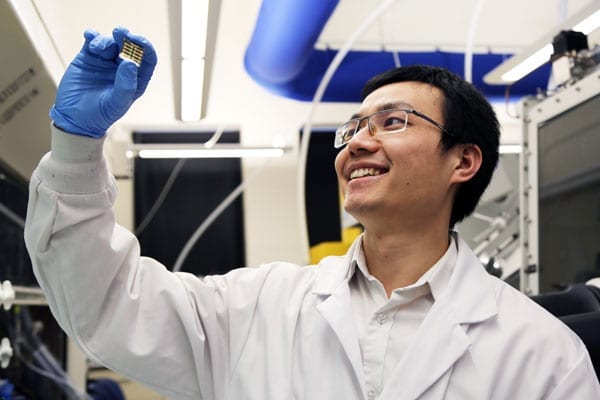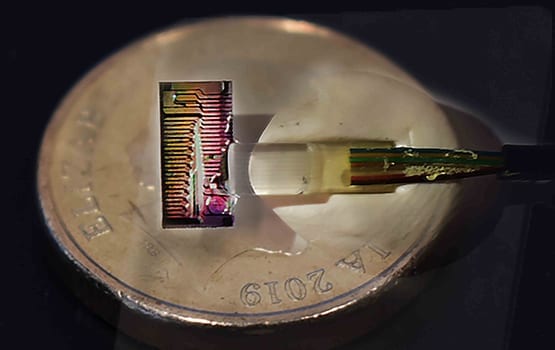A sample of some of the perovskite cells used in the experiment. Photo: UNSW
Under continual exposure to the Sun and other elements, solar panels experience extremes of heat and humidity. Experiments have shown that under such stress, unprotected perovskite cells become unstable, releasing gas from within their structures.
“Understanding this process, called ‘outgassing’, is a central part of our work to develop this technology and to improve its durability,” Professor Ho-Baillie at University of Sydney said.
“I have always been interested in exploring how perovskite solar cells could be incorporated into thermal insulated windows, such as vacuum glazing. So, we need to know the outgassing properties of these materials.”
Low-cost solution
For the first time, the research team used gas chromatography–mass spectrometry (GC-MS) to identify the signature volatile products and decomposition pathways of the thermally stressed hybrid perovskites commonly used in high-performance cells. Using this method, they found that a low-cost polymer-glass stack with a pressure-tight seal was effective in suppressing the perovskite ‘outgassing’, the process that leads to its decomposition.
When put to strict international testing standards, the cells the team was working on outperformed expectations.
“Another exciting outcome of our research is that we are able to stabilise perovskite cells under the harsh International Electrotechnical Commission standard environmental testing conditions. Not only did the cells pass the thermal cycling tests, they exceeded the demanding requirements of damp-heat and humidity-freeze tests as well,” Professor Ho-Baillie said.
These tests help determine if solar cell modules can withstand the effects of outdoor operating conditions by exposing them to repeated temperature cycling between -40 degrees and 85 degrees, as well as exposure to 85 percent relative humidity.
Specifically, the perovskite solar cells survived more than 1800 hours of the IEC “Damp Heat” test and 75 cycles of “Humidity Freeze” test, exceeding the requirement of IEC61215:2016 standard for the first time.
“We expect this work will contribute to advances for stabilising perovskite solar cells, increasing their commercialisation prospects,” Professor Ho-Baillie said.
The Latest Updates from Bing News & Google News
Go deeper with Bing News on:
Perovskite solar cells
- Perovskite Solar Cells: What Are They & How Do They Work?
This renewable energy technology has shown huge potential for over a decade, if only a few large obstacles could be overcome on the road to market.
- Can perovskite solar cells outshine silicon and revolutionize solar energy?
For decades, the familiar blue rectangles of silicon solar panels have dominated rooftops across the globe with the increasing adoption of solar energy. While these panels have become a reliable ...
- Sun-powered supply chains: How solar is lighting up logistics
We explore how DHL and other logistics giants are harnessing solar technology to drive efficiency and sustainability. Sun-powered supply chains: How solar is lighting up logistics. dhl, logistics, ...
- Popular NREL Cell Efficiency Chart Now Better Presents Tandem Photovoltaics
The Best Research-Cell Efficiency Chart is one of the most-visited pages on the National Renewable Energy Laboratory’s (NREL’s) website. It makes frequent appearances in presentations at photovoltaic ...
- Perovskite-based tandem solar cells
The group leader in the Laboratory for Thin Films and Photovoltaics is researching highly efficient solar cells made of perovskite. A single perovskite cell alone does not achieve a higher efficiency, ...
Go deeper with Google Headlines on:
Perovskite solar cells
[google_news title=”” keyword=”perovskite solar cells” num_posts=”5″ blurb_length=”0″ show_thumb=”left”]
Go deeper with Bing News on:
Stabilising perovskite solar cells
- Perovskite Solar Cells: What Are They & How Do They Work?
This renewable energy technology has shown huge potential for over a decade, if only a few large obstacles could be overcome on the road to market.
- Can perovskite solar cells outshine silicon and revolutionize solar energy?
Perovskite, a revolutionary material, promises to surpass silicon efficiency and usher in a new era of affordable, sustainable solar energy.
- Light, flexible, efficient: Perovskite-based tandem solar cells
Today, more and more Swiss roofs boast large black and blue rectangles that convert sunlight into electricity. The blueish color comes from silicon crystals, as the majority of solar cells available ...
- Perovskite-based tandem solar cells
The group leader in the Laboratory for Thin Films and Photovoltaics is researching highly efficient solar cells made of perovskite. A single perovskite cell alone does not achieve a higher efficiency, ...
- Best Solar Panels For Homes Of 2024
Commissions do not affect our editors' opinions or evaluations. Solar panels and their accessories unlock the boundless energy from sunshine and transform it into useful energy at home.
Go deeper with Google Headlines on:
Stabilising perovskite solar cells
[google_news title=”” keyword=”stabilising perovskite solar cells” num_posts=”5″ blurb_length=”0″ show_thumb=”left”]











